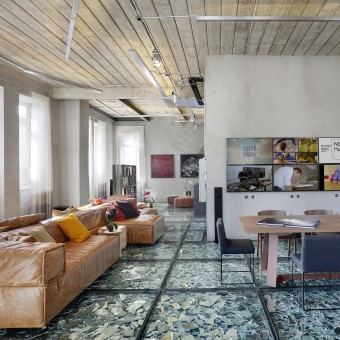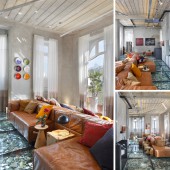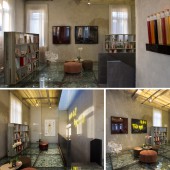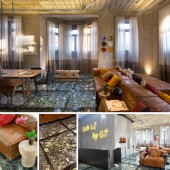Lab LZ by GT Sensory showroom by Gisele Taranto Arquitetura |
Home > Winners > #51021 |
 |
|
||||
| DESIGN DETAILS | |||||
| DESIGN NAME: Lab LZ by GT PRIMARY FUNCTION: Sensory showroom INSPIRATION: The intent of this lab is to get people out of their comfort zone and spur them to think and participate in our experiences. A construction method has several layers of coatings and this Lab design has the purpose to freeze the retaining walls and ceiling unfinished to show that there will have layers of different thoughts. We want to bring up discussions about solutions in different areas that influence the way we inhabit and live, and what future we should expect or in fact is already reality. UNIQUE PROPERTIES / PROJECT DESCRIPTION: The environment Lab, although fully integrated, presents an area sectorization. We have a first area of consulting, such as a library. There is also a second area, living/lounge with a large asymmetrical sofa, and a third area, meeting/working. The Lab have a suspended glass floor and mirror shards in the empty space between the existing subfloor and finished floor. The significance of the mirror comes to complement the concept of what we hope with this work: depth and reflection. OPERATION / FLOW / INTERACTION: As in any process of creating, the questioning is necessary. The idea is that this Lab is a place to hold meetings and talks with various areas of professionals. Participants may be actual or virtual and may be in Brazil or other countries. PROJECT DURATION AND LOCATION: The project started in July 2015 and finished in August 2015 in Rio de Janeiro. It was exhibited in Villa Aymore – Ladeira da Gloria, 26 – Gloria, Rio de Janeiro, from September to October 2015. FITS BEST INTO CATEGORY: Interior Space and Exhibition Design |
PRODUCTION / REALIZATION TECHNOLOGY: All the furniture is part of the LZ Studio's collection, contemporary store that, like Gisele Taranto Architecture, is concerned to present and question new concepts and values. Its universe includes famous brands from national and international designers. And for this Lab, we decided to merge these two worlds. SPECIFICATIONS / TECHNICAL PROPERTIES: Library sector: Joop bookshelves designed by Gisele Taranto Arquitetura, Pebbles ottoman from Flavia Pagotti for Salvatore, Bololo chair, by Leo Capote, and side tables Mix It, from Arik Levy for Desalto. Living / Lounge sector: Lego leather sofa from Estudio Bola with decorative cushions with Patricia Urquiola fabrics from Kvadrat, wooden stools Cheese, Pinocchio, Nano and Bricolage from Riva 1920, side tables Mix it Arik Levy for Desalto, side table Bak from Jader Almeida, side table Wireframe from Piero Lissoni for GlasItalia, as well as two light fixtures by Verner Panton. Meeting / Working sector: Tev table by Jader Almeida, Bilanx swing from Rodrigo Calixto for Oficina Ethos, Merano chairs from Alex Gufler for Ton, C60 Chair from Carbon Design with Kvadrat fabric and Diesel Overdyed chair from Moroso. TAGS: Interior, Showroom, glass, mirror, layers, inovation, sensory, art, casacor RESEARCH ABSTRACT: Considering that 25 years ago the movie Back to the Future imagined a world in 2015 with cars and flying skateboards, we found that this reality is still far from being achieved. Similarly, if we analyze the cartoon series The Jetsons, originally shown between 1962 and 1963, we see a family that lived in 2062 with a major technological breakthrough, with flying cars, suspended cities, robots as servants, and everything that goes to imagine the future. Even this date still being too distant and some aspects of the design have already become reality, will we dwell in cities suspended? Is it just a financial or bureaucratic issue that hinders us? Or doesn’t the society really crave this way? As Marina Abramovich invites her viewers to participate in her method, we want to offer a trip to new ways and ideas. This space is not static; we want the visitor to try it. QR codes are placed on the walls, in order to help visitors with this connection. Our videos show researches and projects from Brazilian and foreigner Universities, as well as detailed explanations from the artists themselves, regarding the art pieces displayed in the space. From COPPE/UFRJ, project like Maglev-Cobra – a magnetic levitation train -; Pecem’s Wave Energy Plant; the Blue Project; and the researches on the second generation biofuels, among others. The Piet Zwart Institute, from the Netherlands, will show the Next habitat project, which was in this year’s Milan Design Week, in Ventura-Lambrate. Students from PUC-Rio, on the other hand, will be developing a research with Casa Cor visitors during the event. They will be working on a project that somehow meets the design expectations for the future. CHALLENGE: As part of a globalized world, we want to use furniture and objects from well-known national and international designers, to handle high-end technology in the experiments, to take advantage of sustainable, elegant and creative lighting, and to create synergy through art pieces that could somehow merge all channels together. ADDED DATE: 2016-09-30 19:56:40 TEAM MEMBERS (8) : Architect/Designer/Partner: Gisele Taranto, Architect: Rafael Pessanha, Architect: Rui Loureiro, Architect: Paulo Bandeira, Architect: Rafael Guedes, Architect: Vera Mandarano, Architect: Jorge Vinicius and Secretary: Anne Rocha IMAGE CREDITS: All photos were made by MCA Estudio |
||||
| Visit the following page to learn more: http://giseletaranto.com | |||||
| AWARD DETAILS | |
 |
Lab Lz by Gt Sensory Showroom by Gisele Taranto Arquitetura is Winner in Interior Space and Exhibition Design Category, 2016 - 2017.· Read the interview with designer Gisele Taranto Arquitetura for design Lab LZ by GT here.· Press Members: Login or Register to request an exclusive interview with Gisele Taranto Arquitetura. · Click here to register inorder to view the profile and other works by Gisele Taranto Arquitetura. |
| SOCIAL |
| + Add to Likes / Favorites | Send to My Email | Comment | Testimonials | View Press-Release | Press Kit |
Did you like Gisele Taranto Arquitetura's Interior Design?
You will most likely enjoy other award winning interior design as well.
Click here to view more Award Winning Interior Design.








